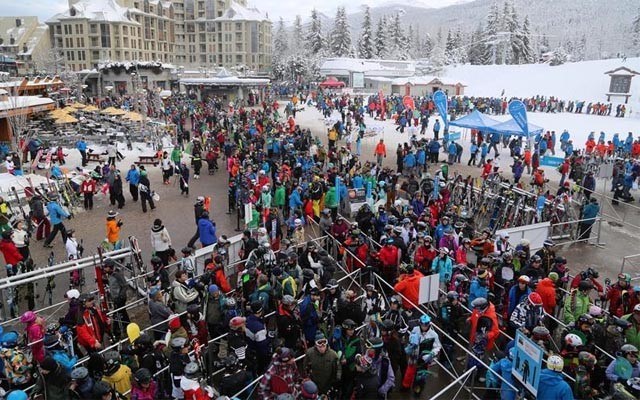In the midst of one of the best ski seasons in recent memory, the Colorado Association of Ski Towns (CAST) is coming to Whistler.
"Many of my members felt we could learn a lot from Whistler and what they've accomplished as a world-class destination resort community," said Joyce Burford, executive director of CAST.
The association is made up of all the big players in the Colorado ski industry, from Aspen and Breckenridge to Telluride and Vail. Whistler is considered an associate member.
Topics on the agenda for the January 20 and 21 meeting — one of five annual meetings held by CAST — include vacation rentals, transportation, parking, economic development, planning, housing and more, Burford said.
And some time has been set aside to get some skiing in, of course.
When they hit the mountain, members of CAST will be counted amongst some record-breaking numbers for Whistler Blackcomb (WB).
Total visits for the fiscal year to January 3, 2016 were 604,000 compared to 514,000 the year before — the highest number of visits to date in WB's history.
"Considerable momentum from both destination and regional markets combined with excellent winter conditions resulted in a busy Christmas holiday period and the highest year-to-date visitation in our history," said WB's president and CEO Dave Brownlie in a Jan. 6 press release.
"Looking ahead, we are optimistic about the remainder of the ski season as both season pass and frequency card sales and hotel room bookings are pacing ahead of the same time last year."
The bountiful snow conditions and weak Canadian dollar have driven growth in all of WB's four key markets — Canada, U.S., Europe and Asia Pacific, said David Wilcox, WB's manager of finance and investor relations.
"It's not only the low Canadian dollar, though, that has been affecting visitors coming to Whistler," he said, noting that WB's involvement with the Mountain Collective Pass, its designation as the best overall mountain resort by SKI Magazine and investments in things like the Whistler Village Gondola, Rendezvous Lodge and Crystal and Harmony zones have played a factor as well.
"We see a direct correlation between visitors to WB and those upgrades," Wilcox said.
While Western Canadian resorts enjoy the here and now, it's hard to say for sure what the future holds for the industry.
In the U.S. demographics, at least, there is reason for cautious optimism.
The average age of U.S. skiers fell slightly for the first time in years last season.
"We've been gradually seeing an increase in the average median age over the past decade or more," said Dave Belin, director of consulting services for tourism and recreation research firm RRC Associates.
"Then this past season was the first time we really saw the average age decline."
In the 2014/15 ski season, the average age of snowsport participants was 38.5 years old — a slight drop from the average of 39 years old seen a year prior.
"What you're seeing is that, fundamentally we've already experienced in some significant way the baby boomers ramping down their levels of participation," explained Nate Fristoe, director of operations for RRC.
"We've actually seen somewhat encouraging growth in the millennial component (aged 18 to 34) and also the Generation Z component (17 and under)."
Asked if he feels it's a trend that will continue, Fristoe said: "I think we're all still very cautious about what it takes to grow the industry and getting our fair share of millennial growth."
In Canada, where there are about 2.1 million ski and snowboard participants compared to about 10 million in the U.S., the numbers were up slightly last year — the average age in 2014/15 was 41.4, up from 38.6 in 2013/14.
David Lynn, outgoing president and CEO of the Canada West Ski Areas Association (CWSAA), said that getting young people involved in the sport has been talked about his entire time with the CWSAA.
"There's different things that have been done," he said, pointing to the Canadian Ski Council's Grade 4 and 5 SnowPass program or WB's Never Ever Days, which lets newcomers to the sport try it out with lessons, rentals and a ski pass for $25.
"Those kind of programs are, in my mind, critical to the future of the sport, because there are barriers to entry," Lynn said.
"We compete with other sports obviously, other winter sports, and we also compete with things that are completely unrelated to our industry."
Engaging young people is also crucial to the industry from a staffing perspective, Lynn said.
"We are conducting a survey on labour conditions as of December 2015, and our initial results show an average shortage of about 11 employees — eight lower skilled and three higher skilled," Lynn said.
According to stats from the provincial ministry of education, there were 60,244 Grade 12 students in B.C. in 2014/15, compared to just 44,236 in Grade 7.
"When you look at that differential, you realize that the number of young people entering the work force is declining," Lynn said.
With ski resorts generally employing a younger workforce, those stats could be worrisome for the industry in future years
"At the end of the day you're going to do the best job you can with whatever labour you have available, but if you're continually understaffed, it undermines the quality of the ski experience and that means that it's going to hurt your skier visits," Lynn said.
"We're competing with the resorts in Colorado and Utah, we're competing with the Alps, we're competing with other parts of the world, so you want to give people that world-class experience."




